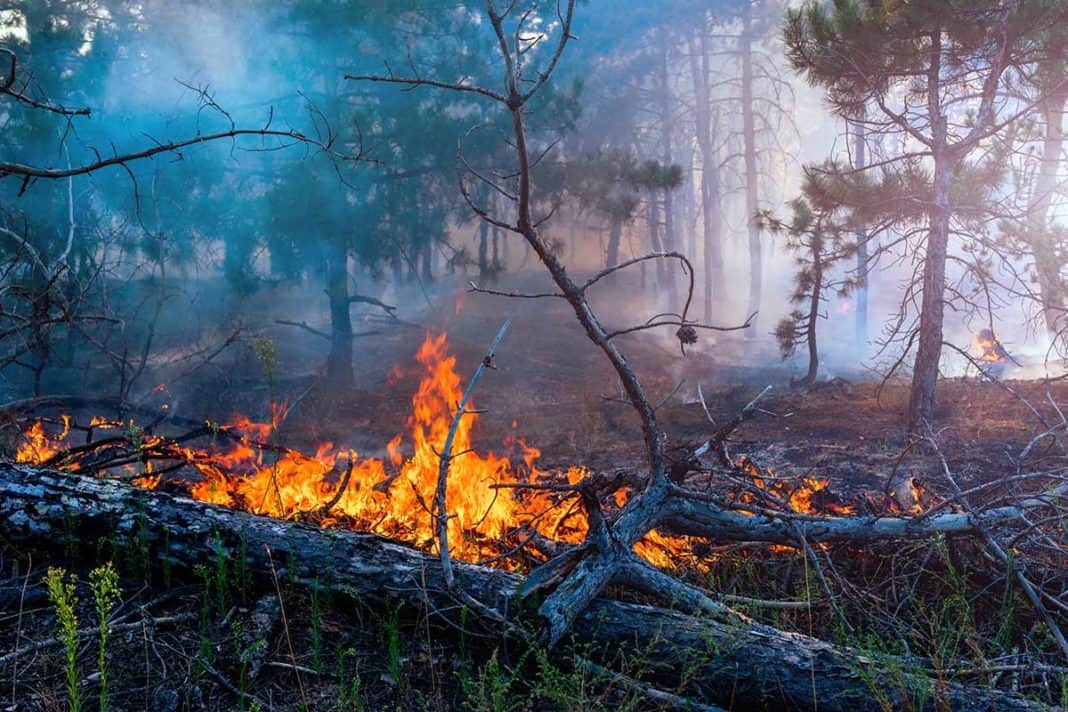MANITOULIN – Ontario’s 2020 wildland fire season officially ended on October 31, closing a season well below Ontario’s 10-year average in total number of fires and total affected areas. Between April 1 and October 31, 2020 there were 607 fires, far below the 10-year average of 870 fires for this time of year. The 15,460 hectares burned was actually less than 10 percent of the 10-year average of more than 162,000 hectares.
Globally, 2020 was a year on fire. It began in Australia where more than 18 million hectares burned over the 2019/2020 season, killing at least 30 people and millions of animals and destroying more than 2,700 homes. A record number of wildfires burned in the Arctic under record high temperatures while fires also burned out of control in Indonesia, the Pantanal wetlands and the Amazon forest in Brazil, central Argentina and closer to home in Oregon and California. Smoke from the California fires reached as far as Northern Europe. More than 150 Ontario fire personnel were deployed to help combat wildfires in Australia, Quebec and Oregon this year.
Ontario’s fire season got off to a slow start because of lingering snow cover and above normal precipitation in the spring, said Maimoona Dinani, spokesperson for Ontario’s Ministry of Natural Resources and Forestry (MNRF). COVID-19 was a factor as well. “Recognizing the compounded risks facing firefighters and communities threatened by fire due to the COVID-19 pandemic in 2020, MNRF had to prioritize early detection and aggressive initial response to keep new fires small. We also implemented a restricted fire zone across Ontario’s legislated fire region from April 3 to May 16 to reduce the risk of preventable human-caused fires,” she said.
A number of provinces had restrictions on outdoor activities throughout the spring at least, some maybe continuing into the summer, agreed Richard Carr of Natural Resources Canada, Canadian Forest Service. “There was maybe a little less human activity in the forest so the number of human-caused fires may have dropped a bit. I think the big difference was the weather.”
The fires in the western United States began in mid-summer and kept going, with fires still happening in parts of California, said Mr. Carr. Those areas experienced rain up until the middle of May or early June and then it just stopped, leading to quite a few weeks of dry weather. Regular rainfall amounts through spring and summer in most of Canada helped hold the number of fires and area burned down. Only New Brunswick and Quebec saw more fires than average, he said. “In some areas of Canada the little bar on the graph doesn’t even show up, the area burned was so little.”
Conditions were much the same in Ontario as they were across the country. The province did not experience many long hot, dry periods that would produce an extreme fire hazard. “Hard work by Ontario’s Fire Rangers as well as more precipitation in the province kept any of the fires we did get at a relatively manageable size,” added Ms. Dinani. “The same trend of lots of precipitation through the fall until the end of the fire season led to a quiet fall season as well with minimal new fire starts.”
Experts agree that hotter, drier and longer seasons due to climate change are changing the nature and intensity of wildfires. “We’ve probably seen that over the past 10 or 20 years there have been more sustained fire seasons, probably lasting a bit longer,” said Mr. Carr. “We’ve got bigger fires. We’ve got fires in areas that historically haven’t had many fires: Vancouver Island, far northwestern British Columbia, Ontario right along the Hudson Bay lowlands and the western shoulder of James Bay. Certainly, there have been fires from time to time that are a bit bigger than usual.”
In Canada there are more sustained periods of warm, dry weather with some areas having a shorter winter season, less snow cover or warmer temperatures that melt the snowpack down early and these can lead to earlier starts to the fire season. “I think the way the forests have been managed has led to more intense fires; there’s just more wood available to burn,” Mr. Carr noted. “I don’t know if it’s contributing to changing the length of the fire season, but maybe it’s making fires more intense.” As well, aspen and white spruce have died off during some fairly severe drought years and dead trees in the forest will probably burn more readily, he said. Droughts not only allow more fires to happen, but also change the nature of forests so they burn more readily.
Fire seasons have been observed to be getting longer in Ontario, said Ms. Dinani. “MNRF fire weather stations have recorded increasing temperatures over the last 50 years; the predicted increase in temperatures may lead to more dry lightning occurrences, which could cause an increase in fire occurrences. Increasing temperatures and the occurrence, duration and extent of drought, insect and forest disease outbreaks are likely to create a more fire prone forest and increase the size and severity of fires.”
“We know that forest fires do release methane and CO2, things that constitute greenhouse gases,” Mr. Carr said. “Different tree species may release different types of gases or different amounts. We do have ongoing projects that relate to determining how much material gets consumed and how much gases get released. Part of the problem is determining how much of the fuel (wood and organic matter on the forest floor) gets consumed in a fire and that varies by species and weather conditions. For example, very hot, dry and windy conditions would lead to fires that burn quite deeply and burn off all of the organic material.”
Fluctuations in climate are measured in decades. “The number, size and intensity of wildland fires, and the amount of area they burn, are highly variable and are strongly influenced by the variability of weather patterns from one year to the next,” Ms. Dinani said. Because of this variability it is difficult to connect any specific single fire to the effects of climate change. However, climate change combined with other factors is expected to increase the occurrences and associated overall risks of wildland fires.
The way in which natural resources are managed can also influence the balance of GHGs, and sustainable forest management activities can enhance carbon storage .“While wildland fires do result in the emission of GHGs into the atmosphere, 90 percent of fires are small (under four hectares) and do not create a significant release of greenhouse gas emissions. The 10 percent of wildland fires that do grow large are the result of fire management decisions to allow a fire to burn under low risk conditions or when severe weather or other uncontrollable circumstances occur.”
While large wildland fires can release significant amounts of greenhouse gas emissions, the forest begins to reabsorb carbon from the atmosphere as it regenerates. New forests absorb carbon at a higher rate than older forests thus allowing for sequestration of greenhouse gas emissions from a wildland fire to occur with new growth.
Fire is a natural part of the forest landscape and some tree species depend on fire for reproduction, said Mr. Carr. They need the heat to burst open their cones to start the new seedlings. “There’s a forest regeneration that comes from fire where there’s a natural succession of plants and animals into a whole ecosystem. It’s good in moderation. Naturally there’s going to be fluctuations and it’s quite variable with the human influence. It’s been a part of the landscape for thousands of years and a lot of things have adapted to it.”
“We’ve had a number of years where we’ve had three or four million hectares burned which is about double the average and we’ve had some fairly low ones in the past when there’s less hectares burned across the country. This is one of them. Usually they tend to rebound fairly quickly afterwards again and then next season will be different again.”






